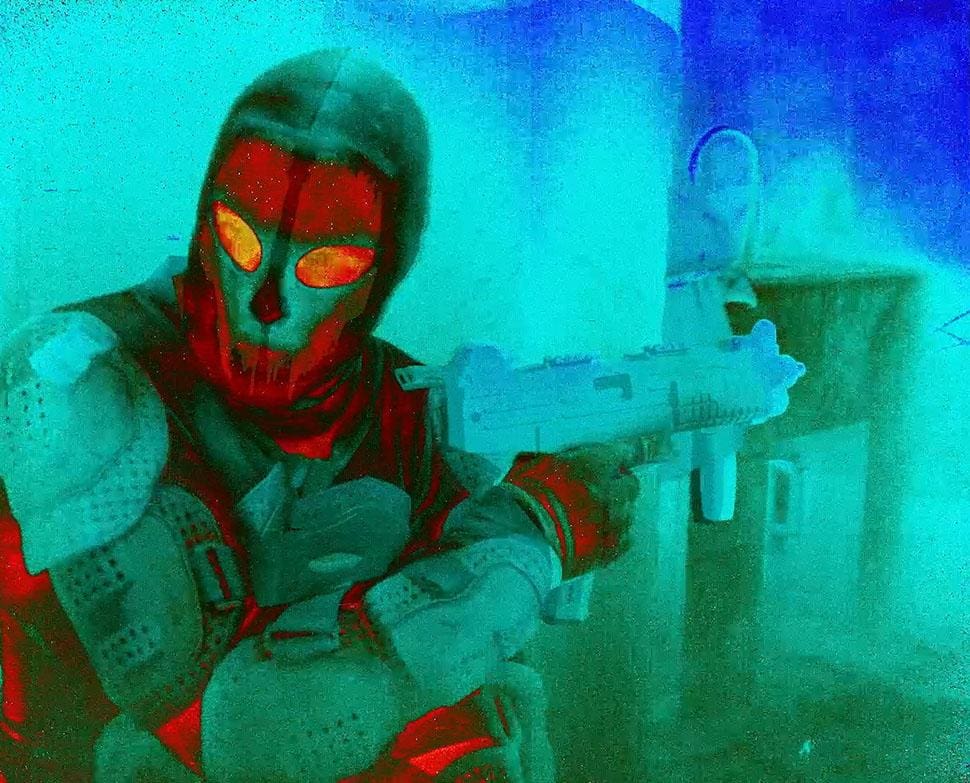
Harmony Korine’s Aggro Dr1ft is a wholly unique experience. The entirely infrared tale of an assassin is visceral, crass, repetitive. Sometimes it feels like a nightmare, others, like the delightfully absurd, futuristic 2013 video game Far Cry: Blood Dragon. It’s not for everyone, but those for whom it is, should see it. Indeed, how you react to the sentence, “Harmony Korine’s infrared tone poem about an assassin,” will most likely determine how you’ll react to the movie. However, while the film’s target audience may be easy to determine, it’s not so easy to review. Aggro Dr1ft is a film that demands to be experienced, eschewing traditional narrative for a more unique, impressionistic nature. It wouldn’t be quite true to call it plotless—it has betrayal, conflict, vengeance, all that good stuff—but Korrine is more interested in the emotions related to these events than he is in following things like, say, a three act structure.
This is where the much-touted infrared aesthetic comes in. It both distinguishes the perspective of the unnamed assassin (Jordi Molla) as singular, yet establishes it as something that poisons the entire world. As the film progresses, you’ll get the sense that he’s a man of honor to the extent someone in his line of work could be (kind of like Robert DeNiro’s Neil McCauley in Heat), but this opening establishes that extent. He violently chokes and stabs his unknown victim, as a gigantic, demonic CGI figure lurks in the background (hence the Far Cry: Blood Dragon comparisons). The horrific violence, the theatrical spirituality, and the infrared nature of the image all coalesce to give the sense that, though only few can actually see the world this way, it can be seen this way. It exists, even if most don’t see it. This violent aesthetic permeates the world even if you are not a violent individual. It lurks, it haunts, and it can find you at any moment.
The use of infrared calls to mind many things. It can be associated with realism, given its real world applications. Korine understands this, but he also sees opportunities for unique, stylish artifice. Artificiality isn’t limited to a CG demon: Korine and cinematographer Arnaud Potier use the colors to treat the environment and bodies like a new, evolving mural that they can paint any way they please. In keeping with this, the film has a consistently used and interesting effect related to tattoos. The film’s main antagonist, an absurdly muscular, sword wielding assassin who keeps women in cages, has perpetually evolving tattoos.
The rough texture and perpetually evolving nature of the tattoos gives them a painterly quality. Even the editing is able to march to its own tune. There are times you won’t know where one shot ends and another begins. One moment, while on a boat, looking down on an assortment of women dancing in a hot tub. The next, almost without realizing it, you’re still on the boat, but being looked down on by Travis Scott. Moments like this attest to the fact that, despite very much not being for kids, there’s an adolescent charm to Aggro Dr1ft’s spirit. The assassin doesn’t just kill to kill: his wife, daughter and son are all that matter to him. When he plays with his children, reads them a story, or puts them to bed, the film could almost be a saccharine Walmart commercial, just in infrared, but it retains the same earnestness as when the assassin dispatches a man by slitting his throat.
However, by the end of the film, if the assassin is to be believed, it’s not the violence that wins out, but love. Not even just love, but God, for, so says the assassin, God is love. Were it not for the time he spends with his wife and children, this assertion would be absurd, but even with that time, you personally, may struggle believing that Aggro Dr1ft fully believes it. This is a sympathetic struggle. Finding love in a worldview that poisons our world, in the grotesque, in a film whose foundation is rooted in adolescent, masculine pleasures, may just be a disingenuous expression for those adolescent pleasures. Love is easily distorted in the name of narcissism, especially when related to being a noble, badass white knight who’s better than other assassins because of his code of honor.
But if Aggro Dr1ft’s infrared can reveal demons in clouds, painterly, moving tattoos, and a world beyond traditional editing, then, well, why not love?


Comments are closed.